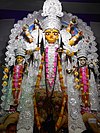Dashabatar Cards
Dashabatar Cards (দশাবতার তাস) is a card game of West Bengal. It first originated in Bishnupur, the town of Bankura District.[1] In the 16th century, Bir Hambir, the king of Bishnupur, invented this card. There are ten avatars of Bishnu in the cards.[2] It is a unique example of Bengal’s folk art.[3]
Origin[]
In 1592, Bir Hambir became king of Bishnupur. He had a great relationship with Akbar, so, a lot of times he went to Akbar's court. Seeing the playing of cards he was surprised. Coming to his kingdom, he thought of creating a new card in God-goddess of uniqueness. According to his directive, artist from Bishnupur, Kartik Faujdar, made the Dashabatar Cards.[4] kings of Mallabhum play this card at leisure for entertaining.[5][6]
However, Indian scholar Haraprasad Shastri said that this game first originated in the 8th century. In 1895 he said in the Asiatic society's journal:
...I fully believe that the game was invented about eleven or twelve hundred years before the present date.
Because the placement of Jagannath (Buddha) is in the 5th position in Dashabatar card, but in common belief, Jagannath is in the 9th position.[7]
Prabhat Kumar Saha, an expert on Dashavatar cards, said: "Malla dynasty ruled from about 12th century AD to 1622". He confirmed that the Foujdars were the only makers of these cards in Bengal.[4]
Method[]
The artists from the Faujdar family of Bishnupur specialise in making these cards. At first, a piece of cloth is folded a number of times. Then glue is pasted, made from tamarind seeds. After drying this, a layer of chalk dust is applied on the cards. Both sides are evened out with a smooth stone. The cards are then cut into round shapes of a 4.5-inch radius. Various deities and their symbols are painted on these using various colours. On the reverse part, a layer of lac and vermillion is applied.[3]
Cards[]
Dashavatar cards are the 10 avatars of Lord Vishnu - Matsya, Kurma, Baraha, Nrisingha, Buddha (Jagannath), Baaman, Ram, Balaram, Parshuram and Kalki are drawn on these cards.
The Dashavatar card game is a complicated one. It is played using 120 cards with numerous rules and regulations.[3]
Sital Fouzdar claims to be the 87th generation of artisans. Nowadays, Vidyut Fouzdar makes them.[8][4]
See also[]
See also[]
| Wikimedia Commons has media related to Dashavatara ganjifa set. |
References[]
- ^ Singh, Shiv Sahay (5 December 2015). "Preserving Bishnupur's heritage". The Hindu. Retrieved 24 January 2018.
- ^ "দশাবতার তাস, হারিয়ে যেতে বসা বাংলার এক শিল্প". Eenadu English Portal (in Bengali). Archived from the original on 2018-01-25. Retrieved 2018-01-24.
- ^ a b c "Dashavatar Cards". Biswa Bangla. Retrieved 2018-01-24.
- ^ a b c Das, Soumya; Das, Soumya (2015-02-05). "Dashavatar card-making faces extinction in Bengal". The Hindu. ISSN 0971-751X. Retrieved 2018-01-24.
- ^ Manaranjan Chandra (2002). Mallabhum Bishnupur. Kolkata. p. 283.
- ^ "Lost Game: Dashabatar Taas of Bishnupur - The Chitrolekha Journal on Art and Design". The Chitrolekha Journal on Art and Design. 2013-03-01. Retrieved 2018-01-24.
- ^ "দশাবতার তাস – এক বিলুপ্তপ্রায় শিল্প ও এক বিলুপ্তপ্রায় খেলা". bandyopadhyaya.blogspot.in. Retrieved 2018-01-24.
- ^ "Lost Game: Dashabatar Taas of Bishnupur – The Chitrolekha Journal on Art and Design". The Chitrolekha Journal on Art and Design. 2013-03-01. Retrieved 2018-01-24.
- Indian card games
- Indian handicrafts
- Arts in India
